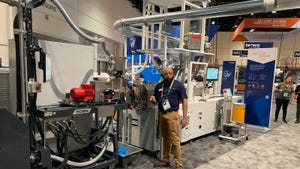Chevy Volt recycles Gulf oil booms into underhood parts
Chevrolet is repurposing plastic from oil-soaked booms used in the Gulf oil spill into underhood parts for its electric Volt vehicle. GM, in conjunction with Tier One supplier GDC Inc., will spare hundreds of miles of booms from incinerators and landfills, instead mixing them with other recycled plastics, rubber, and virgin material for components that deflect air around the vehicle's radiator.
December 21, 2010
Chevrolet is repurposing plastic from oil-soaked booms used in the Gulf oil spill into underhood parts for its electric Volt vehicle. GM, in conjunction with Tier One supplier GDC Inc., will spare hundreds of miles of booms from incinerators and landfills, instead mixing them with other recycled plastics, rubber, and virgin material for components that deflect air around the vehicle's radiator.
Sharon Basel, who works in environment and energy communications for GM, told PlasticsToday that the company has already processed more than 100 miles of the polypropylene (PP) boom materials, and with collection in Louisiana ongoing, that figure could ultimately be doubled. Other than metal clips or non-polymer-based ropes, GM and its partners on the project are able to reclaim the entire boom. From an onsite centrifuge, which draws out the bulk of the sea water and oil, the booms are sent to Lucent Polymers in Evansville, IN, which compounds and densifies the material into what Basel describes as “plastic shavings."
These deflectors will be comprised of 25% boom material and 25% recycled tires from GM's Milford Proving Ground vehicle test facility, with the remaining materials a mixture of post-consumer recycled plastics and other polymers. GM estimates that by recycling the plastic booms it will save 100,000 lb of waste from landfill.
Chevy's Volt recycles plastic oil booms into new underhood parts. |
The Chevy Volt will feature radiator deflector components partially composed of the plastic oil booms that soaked up spilled petroleum in the Gulf. |
Mike Robinson, GM's VP of Environment, Energy, and Safety policy noted that the automaker reuses and recycles material by-products at its 76 landfill-free facilities every day. "This is a good example of using this expertise and applying it to a greater magnitude," Robinson said.
GM's collaborators in the plastic recycling project include Heritage Environmental Services, which managed the collection of boom material along the Louisiana coast; Mobile Fluid Recovery, which used a massive high-speed drum to spin the booms dry; and Lucent Polymers, which markets a line of recycled polymers dubbed Ecollent.
GDC Inc. (Goshen, IN), which has an in-house material development lab, is creating components, using its patented Enduraprene material process to compound the resin with other plastic compounds. Made from 100% recycled materials, GDC describes Enduraprene as an engineered thermoplastic elastomer (TPE) produced from recycled rubber and thermoplastics. Enduraprene uses a patented de-vulcanization process to satisfy OEM specs and reportedly create a superior product when compared to other masticated and rubber "filled" products.
GDC extrudes the material mixture into a sheet, which is then die cut and pressure formed into the final parts. The deflector is composed of four pieces altogether, with upper and lower parts, as well as two sides. GDC was already under contract to create the deflectors from standard materials, but once it decided to move forward with the project, it had the new parts based on the recycled content compound validated.
Volt’s with the boom-based deflector are on the road now, with GM beginning shipping of the all-electric vehicles to consumers in early to mid-November. The initial vehicle build for the first year will be 10,000 units, and all of them will feature the reclaimed plastic boom deflector. “Recycling and reuse is a really big deal for us as a company,” Basel said. “Keeping things out of landfill, or at least reducing what goes in, is really important to GM.”
Basel said that like everyone, as GM watched the spill unfold in the Gulf, many at the company said, “I wish I knew a way I could help.” GM ultimately contacted Mobile Fluid Recovery based on the automaker’s own experience with with recycling absorbent materials. “It became apparent that [GM] jlent expertise that others maybe didn’t have,” Basel said.
GM says it uses recycled and renewable plastics and other material in a number of its cars and trucks, which are themselves at least 85% recyclable. GM currently redirects used tires, plastic bottles, denim, and nylon carpet from landfills for reuse in select GM vehicles. In terms of in-house post-industrial recycling, GM facilities recycle 90% of the waste they generate. The automaker recently announced that more than half of its worldwide facilities are now landfill free, with zero waste generation.
The Steel Recycling Institute reported in a recent study that automobiles are recycled more than any other product, with nearly 100% of vehicles recycled for their iron and steel content, which comprise 67% percent of each vehicle by weight. In 2008, this resulted in more than 14.8 million tons of steel recovered for re-use from scrapped automobiles.
Groups like Steel Market Development Institute (SMDI) are promoting advanced high-strength steels (AHSS) in automotive, saying they require less energy and emissions to produce than other automotive structural materials, while making lighter parts that reduce vehicle weight, increase fuel economy, and are fully recyclable. In an April 2010 release, the SMDI reported that AHSS are the fastest-growing material in new vehicles today.
The American Chemistry Council (ACC) notes that in vehicles many plastic components can weigh up to 50% less than similar components made from other materials. Today's average light vehicle contains 332 lb of plastics and composites, which equates to 8.3% by weight.
About the Author(s)
You May Also Like


